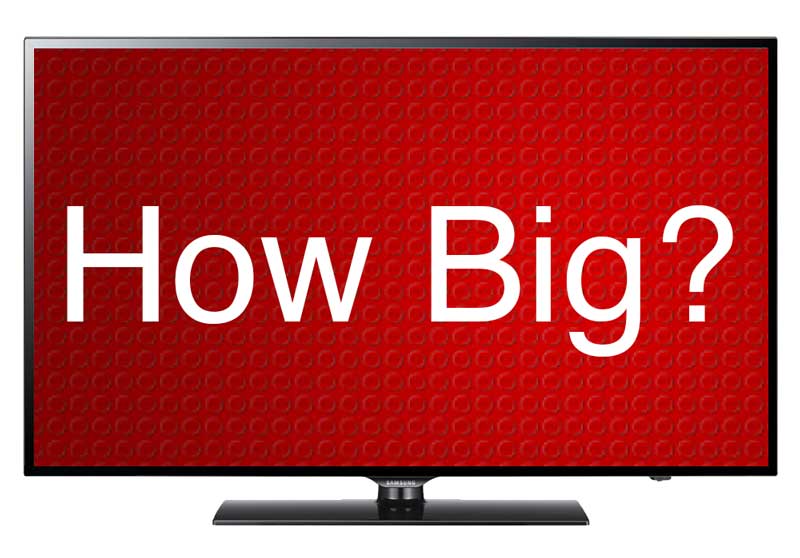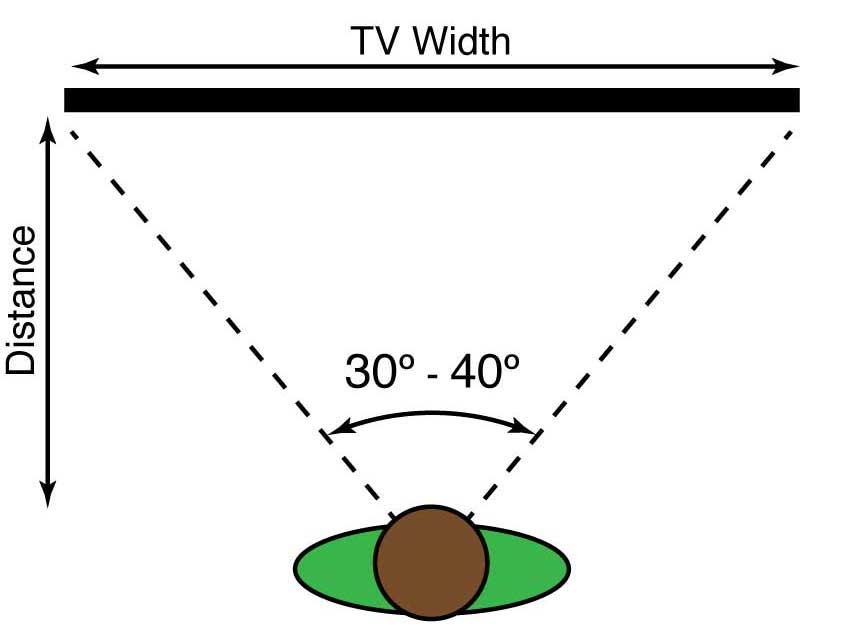TV Size and Viewing Distance Calculator
Find out how big of a TV you should get and how far away you should sit using our TV viewing distance calculator.
If you already have a TV, enter the TV size to find out how far you should place your seating. If you are looking for a TV, then enter the distance from your seating position to the TV to determine which size TV you should purchase.
Calculate How Big of a TV You Should Get
Calculate How Far You Should Sit From Your TV
Recommended TV Size:
This is the distance where your eyes can see the individual pixels
On this page:
- Calculator
- How to Choose the Right TV Size
- Consider Viewing Distance and Viewing Angle
- The Best TV Size Depends on the Content
- How to Calculate the Best TV Viewing Distance
- Optimal Viewing Distance for Various TV Sizes
- Optimal Viewing Distance Based on TV Resolution
- Other Factors to Consider When Choosing a TV
How to Choose the Right TV Size

You might be wondering what size TV you should get. This can be a tricky decision, and the internet is loaded with opinions on the topic.
Believe it or not, there is actually a science to choosing how big of a TV you should get for the optimal viewing experience. There are several factors to consider when selecting a TV size, notably distance and viewing angle, resolution, and the type of content you’ll be viewing.
Our calculator takes these factors into consideration and makes several size recommendations based on the seating distance based on these considerations.
Consider Viewing Distance and Viewing Angle
One of the main determining factors in finding the TV size that is right for your room is the viewing angle from your seating position.
THX has some recommendations for the correct viewing angle to achieve an immersive viewing experience. THX recommends a 36° to 40° horizontal viewing angle for the best viewing experience, and the Society of Motion Picture and Television Engineers recommends a minimum 30° viewing angle.
Using these metrics, the ideal TV size would have a 30° to 40° viewing angle from the seating position.

There are a number of ratios that get roughly close. Multiplying the seating distance by 0.6 will yield a TV size that will be close to a 30° viewing angle, while multiplying the seating distance by 0.84 will get you a TV size close to a 40° viewing angle.
Since these viewing angles are horizontal viewing angles, the result will be the ideal TV width. Then, using an aspect ratio calculator, you can find the screen height to get the ideal TV size.
If your seating distance is 96″, for example, a 58″ TV will have a viewing angle of 30° and an 80″ TV will have a 40° viewing angle. We have found that a 38° to 40° viewing angle is optimal for the most immersive experience.
The Best TV Size Depends on the Content
What you watch on your TV will determine the optimal size and viewing distance. If you intend to watch 4k Bluray movies, then we have found that a TV size with a viewing angle closer to the 40° mark is more enjoyable.
If you’re watching 1080p television shows in an informal living space where aesthetics are a concern, then you may choose a TV that will have a viewing angle closer to 30° or maybe even less.
You also should consider the type of viewing experience you prefer, which is a subjective decision. One of the most common complaints we hear from people after choosing a TV is that a larger TV would have been better. It’s not very common to hear people admit that they wish they had chosen a smaller TV.
How to Calculate the Best TV Viewing Distance
Part of selecting the right TV for you also involves figuring out what the best viewing distance is for the TV. That might depend on a few factors, such as the size of the room, the type of the room, the use of the TV, and its resolution.
The room’s size will certainly determine the maximum viewing distance, which will undoubtedly have an impact on just how big of a TV can fit in the space.
The type of the room will also impact the right viewing distance. For example, in a living room with the TV mounted over a fireplace, a further viewing distance helps to alleviate neck strain and accommodate room aesthetics in our experience.
On the other hand, in a media room dedicated to movies, sports, or gaming, you might prefer to shorten the viewing distance for an optimal movie experience.
Optimal Viewing Distance for Various TV Sizes
As discussed above, the screen viewing angle is a significant factor in determining the optimal viewing distance. The chart below shows the optimal viewing distances for various TV sizes in the suggested 26° – 40° range.
| TV Size | Optimal Seating Distance |
|---|---|
| 50″ | 5′ 0″ – 7′ 10″ |
| 55″ | 5′ 6″ – 8′ 8″ |
| 60″ | 6′ 0″ – 9′ 5″ |
| 65″ | 6′ 6″ – 10′ 3″ |
| 70″ | 7′ 0″ – 11′ 0″ |
| 75″ | 7′ 6″ – 11′ 10″ |
| 80″ | 8′ 0″ – 12′ 7″ |
| 85″ | 8′ 6″ – 13′ 4″ |
| 90″ | 9′ 0″ – 14′ 2″ |
See a full list of TV sizes and viewing distance ranges for a 4K TV.
Optimal Viewing Distance Based on TV Resolution
The TV’s resolution will also play a role in how far you can sit from the TV. There is a point at which your eyes can make out the individual pixels of the TV screen, and the picture begins to degrade based on your visual acuity.
TVs with higher resolution have smaller pixels that make up the image, which are harder to see at the same distance. This means that you can sit closer to TVs with a higher resolution before you can begin to see the pixels.
You can sit much closer to a 4K TV without making out the pixels and have a more immersive viewing experience than you can a 1080p TV.
The number of pixels on a display in relation to the size is known as pixel density, and it’s measured in pixels per inch, or PPI. Use our PPI calculator to measure the pixel density of your screen.
The viewing distance calculator above takes this into account when recommending a size and seating distance.
Minimum Viewing Distance by Size and Resolution
Is an upgrade to a 4k TV worth it? The chart below shows the distances that the eye can see the individual pixels on the screen.
| TV Size | 1080p Minimum Distance | 4k Minimum Distance |
|---|---|---|
| 40″ | 4′ 11″ | 2′ 4″ |
| 46″ | 5′ 8″ | 2′ 8″ |
| 50″ | 6′ 2″ | 2′ 11″ |
| 55″ | 6′ 9″ | 3′ 2″ |
| 60″ | 7′ 5″ | 3′ 6″ |
| 65″ | 8′ | 3′ 9″ |
| 70″ | 8′ 8″ | 4′ 1″ |
| 75″ | 9′ 3″ | 4′ 4″ |
| 80″ | 9′ 10″ | 4′ 8″ |
| 85″ | 10′ 6″ | 5′ |
| 90″ | 11′ 1″ | 5′ 3″ |
If you can’t see the pixels on the screen at 1080p resolution, then an upgrade to 4K might not be noticeable. If your seating distance is closer than the minimum viewing distance for the 1080p resolution, then an upgrade to 4k will be a noticeable improvement.
Minimum Viewing Distance Formulas
| Resolution | Seating Distance |
|---|---|
| 8K | 0.4x Screen Width |
| 4K | 0.8x Screen Width |
| 1080P | 1.7x Screen Width |
| 720P | 2.7x Screen Width |
| 480P | 4.1x Screen Width |
If you need to find your TV width, refer to a chart of dimensions for common TV sizes or use our screen size calculator.
Other Factors to Consider When Choosing a TV
There are a few other factors that you may wish to consider when selecting a TV size.
The first is room aesthetics. Some rooms may accommodate a 90″ TV based on viewing distance, but if that room is a formal living space, then aesthetics should also be considered.
Safety should also be considered. When placing the TV on a piece of furniture, be sure to consider the TV’s size and weight and the furniture’s weight limit.
Consider the best height to mount your TV, which could determine how large the screen can be. The height of the TV may change the room’s aesthetics and may be a determining factor.
Mounting height should definitely be considered when placing the TV. Learn more about TV mounting costs and different bracket options.
Finally, the budget should factor into your decision when selecting a TV size or resolution. Larger screens and higher resolution displays cost more, and it would be wise to evaluate the cost of the display in the decision when selecting the ideal TV for your application.


